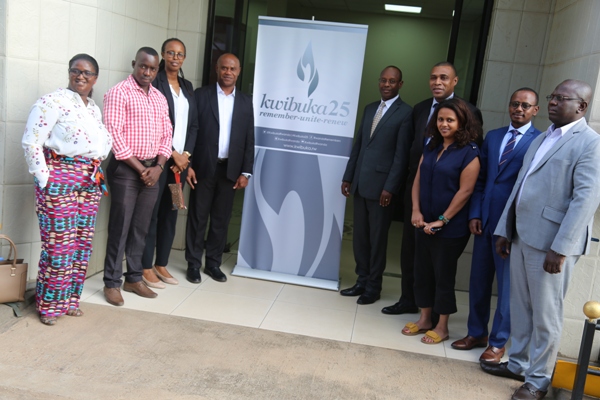
Kigali: Representatives of the Truth, Reconciliation, and Reparations Commission of The Gambia as well as International IDEA Gambia and International IDEA Ethiopia visited the National Commission for the Fight against Genocide (CNLG) to learn and discuss the Genocide against the Tutsi in Rwanda and the ongoing research efforts of CNLG.
After visiting the Kigali Genocide Memorial and learning more about the Genocide against the Tutsi, the visitors were given two consecutive presentations on ongoing efforts relating to the conservation of Genocide evidence and the Gacaca Records archiving project. The purpose of these two presentations was to show the visitors how CNLG, in partnership with other organizations, is actively working to preserve the memory of the Genocide through safeguarding evidential artifacts. The presenter at today’s event, Dr Jean-Damascene Gasanabo, Director General of the Research and Documentation Centre on Genocide at CNLG, led an engaging discussion with the visitors on preservation efforts and reparations in Rwanda.
The first presentation was a look of the preservation efforts that are occurring at the memorial sites in Nyamata and Murambi, beginning with a brief overview of the Genocide against the Tutsi and why preservation is so crucial to the mission of CNLG. The Nyamata project is being carried out by CNLG staff in partnership with the University of Pennsylvania and is primarily looking at the preservation of textiles and other artifacts. The Murambi project has been an ongoing collaboration effort between CNLG and The University Medical Center Hamburg-Eppendorf in Germany. This project is predominantly focused on forensic preservation of the bodies of victims. Both groups hope to expand their work to other sites as well as increase training opportunities for CNLG staff in forensic science. At the interest of the visitors, the presentation also led into a brief discussion on the government aid to Genocide survivors in terms of health, education, and shelter.
Following this, Dr. Gasanabo began a second presentation on the Gacaca archiving project. This is an effort between CNLG and The Aegis Trust to preserve as well as digitalize the paper records of the Gacaca Courts that were part of the reparation efforts following the Genocide. This project has been extremely successful thus far, with written records of all districts having been recorded and nearly 48,000,000 pages from the transcripts being digitalized.
The presentation sparked thoughtful conversations on the challenges of storing and digitalizing the Gacaca records. The fragile documents are susceptible to dirt, humidity, pests, and cleaning chemicals and it is imperative that the staff working on the documents and artifacts receive proper training. The visiting Commission discussed their upcoming report on victims of human rights violations, and how it can be used to inform The Gambian government’s policy actions. Dr. Gasanabo was able to advise on their own document preservation efforts.
The meeting was the first in what is expected to be a long and fruitful relationship between CNLG, International IDEA, and the governments of The Gambia and Ethiopia. CNLG would like to thank the Truth, Reconciliation, and Reparations Commission as well as International IDEA for collaborating with CNLG and promoting the exchange of knowledge for the continuation in the fight against genocide. (Fin)
